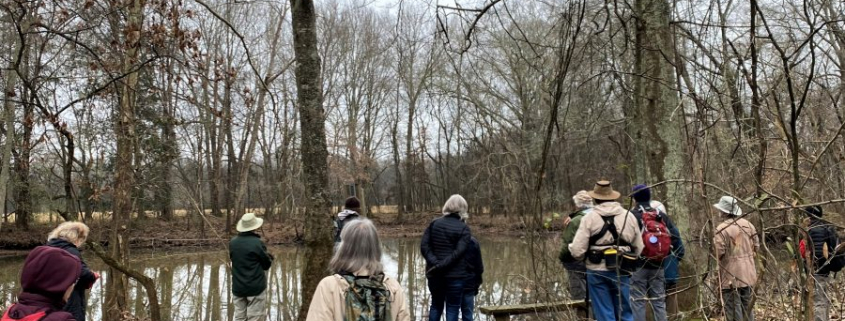Mid-Winter Treks at Goldsmith-Schiffman Wildlife Sanctuary
I returned to Huntsville, Alabama’s Goldsmith-Schiffman Wildlife Sanctuary January 13 and 15, 2022, the first day to dry-run the interpretive hike I co-led on the 15th for 23 participants from the University of Alabama at Huntsville’s Osher Lifelong Learning Institute (OLLI). I focus this Post on the rich diversity of the Sanctuary, especially its multiple habitats, ecosystems, and ecotones.
I’ve written often about the Sanctuary, most recently: https://stevejonesgbh.com/2022/01/18/early-november-2021-b-roll-at-the-goldsmith-schiffman-wildlife-sanctuary/
Water Dominance
December 28, 2021 through January 8, 2022, I recorded 6.96 inches of rain with my industrial grade-home rain gauge. The Flint River, which borders the Sanctuary, overflowed its banks and inundated the Sanctuary during that drenching. We were fortunate that the intervening week allowed the river to retreat to within its banks. However, Sanctuary lowland soils remained saturated. We had alerted hikers in advance to wear shoes/boots to handle conditions. Cloudy skies prevailed during our 1.5-mile hike. The threatened rain arrived later in the afternoon. That evening and overnight I measured another 1.90 inches.
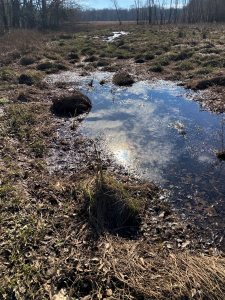
Hidden Spring emerges at the Taylor Road entrance to the Sanctuary, fed from the ridge (visible to the west below left) that stands 800 feet above the Flint River flood plain. The two photos are of Jobala Pond (left) and its outlet stream with a pair of mallard drakes. I’ve pointed out in previous posts that Jobala is a naturalized pond created 80 years ago when highway engineers mined sand and gravel for nearby road construction. The periodic Flint River flooding overtops the pond’s embankment, introducing plant seed and the fish, reptiles, amphibians, and other life that naturalized the borrow pit. Jobala’s waters are clear, evidencing its spring-fed source.
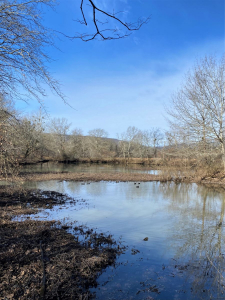

A second borrow pit pond lies just 300 feet from Jobala. The January 13, 2022 photo (below left) shows its muddy water, which in all my visits has never been anything but cloudy. Unlike Jobala, this second pond does not have through-flow constantly refreshing its water. Its turbidity appears to be permanent. Some sediments such as clay particles and organic matter can be chemically suspended, never settling and permitting the water to clear. Other causes of permanent turbidity include bottom-feeding fish, mammals like beavers and muscrats, or cattle. Regardless, the second pond does not offer the aesthetic appeal as Jobala, yet we brought the 1 January 15 hike participants to this pond to draw the contrast and explore possible causes. As I’ve often said, every element of Nature has a story to tell, and every story has lessons for life and living.
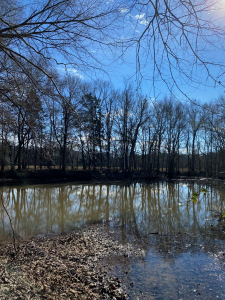
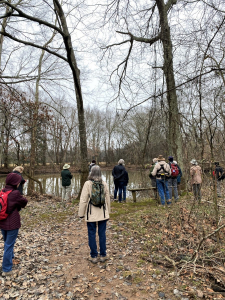
Back in its banks, the Flint Rifer continued to run high. This an arm of the Flint flowing around an island, the far shore. The main channel lies just 200 yards downstream. The island, now isolated by the branch’s full flow, is easily accessible by ankle deep wading during most of the summer. The entire Sanctuary is a dynamic ecosystem, ranging from full flood to quiet calm.
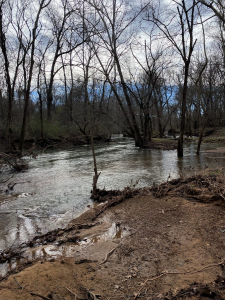
The Flint River had rushed across these meadows within the past ten days. Waterlogged soils will persist through the remainer of the winter and well into the spring. The dynamic interaction of water and land through the seasons is part of the Sanctuary’s appeal and richness.
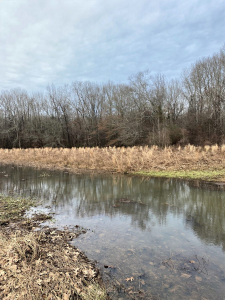
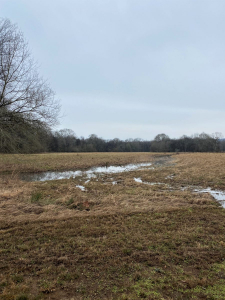
Meadow
Forest, meadow, distant ridge, and the ebb and flow of seasonal water define the Sanctuary. Ecotones (the boundary zones separating habitat types) enrich the Sanctuary. The forest edge below right supports more species diversity than either the interior forest or the open meadow. The ecotones, from my own appreciation perspective, likewise multiply the landscape aesthetic value. Weave in the seasonal changes, from what some would consider the drab winter view, to the fresh greens of spring, to the deep summer verdancy, to the colors of fall, and the aesthetic mosaic is unsurpassed. Even without knowing the shifting landscape complexion, I love the dormant season, when forest and meadows rest and recover as the river occasionally runs wild.
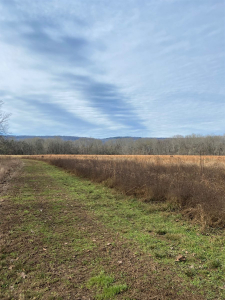
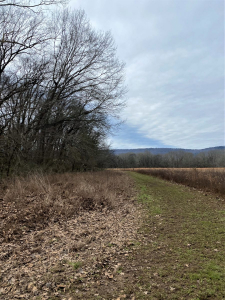
Hikers slip from meadow into forest. The ecotone is less distinct in summer when the separation can be lost in an overwhelming explosion of green. Leonardo da Vinci spoke of edges within paintings:
When you represent in your work shadows which you can only discern with difficulty, and of which you cannot distinguish the edges so that you apprehend them confusedly, you must not make them sharp or definite lest your work should have a wooden effect.
I know little about art, yet I see da Vinci’s wisdom in contrasting the discernable winter boundaries to the softened edges of summer.
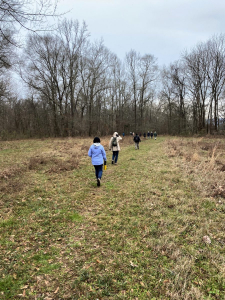
I made that winter/summer distinction comment above, anticipating that I could demonstrate the difference with a simple photo from summer (June 26, 2021) at the Sanctuary. Having the winter/summer images, one above the other, does depict the winter edges as more distinct. The winter details of meadow elements and tree branching within the hardwood canopies are far more interesting. The summer characteristics are blurred greens with little detail within either the forest or meadow vegetation.
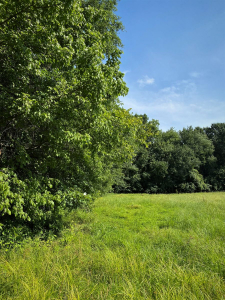
I offer two more sweeping vistas of meadow, edge, forst, and distant hills. Leaving more northern climes to retire to north Alabama, I admit to having dreaded the predominance of summer heat and absent winters that awaited me. However, I have grown to cherish the extended season of fall giving way to spring, with a few winter days thrown in for good measure. Our dormant season is complete, and for that I am grateful. I enjoy days like January 13 and 15, when temperatures made for pleasant hiking. Although soils may be saturated, we seldom have to contend with slushy snow. While nothing beats the marvel of a fresh and pristine snowy landscape, driving on slippery roads at this latitude with motorists unaccustomed to the treachery of frozen surfaces would have kept me at home. Perhaps someday I will hike the Sanctuary under snow cover.
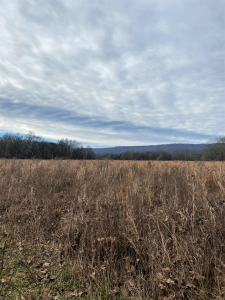
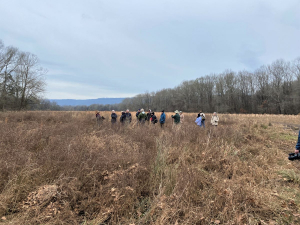
Firmament
To this point, I have not mentioned the sky in this Post. However, a quick look back at the preceding 14 photos will confirm that the sky (January 13 mostly clear; January 15 dull stratus overcast) complements every image. Terra firma and the firmament, two very similar terms for the land and the sky, complete almost every landscape image I have captured. The January 13, 2022, images below placed in my mind that the firmament is an ocean above. I imagined that had this been a warmer day with drier soils, I could have reclined on my back to observe the ocean-sky as though I were on an airliner cruising at 32,000 feet above the Atlantic!
Albert Einstein believed passionately in the power of such imaginings:
Imagination is more important than knowledge. Knowledge is limited. Imagination encircles the world.
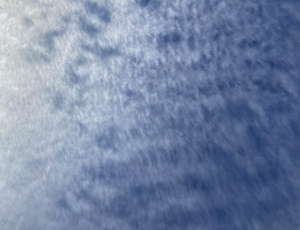
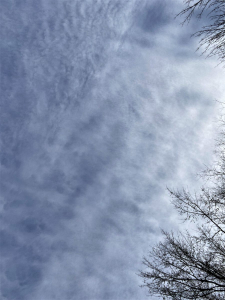
I shall never lose my imagination…my curiosity about Nature…shaped in my youth and sharpened by my practice of the craft across 70 years. It is the youngster in me that I shall strive to nourish until my final glance into the wild.
Other Life features
A 24-inch diameter elm snag stood along an abandoned side-channel of the Flint River. A Dryad’s saddle mushroom cluster sprouts from near the snag’s top, 12 feet from its base, out of my reach.
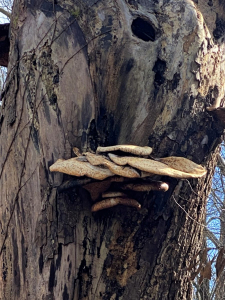
When fresh, Dryad’s saddle is edible. This cluster evidences that the snag serves as a perfect substrate for the mushroom’s decomposing mycelia. Eventually, gravity or a flooding Flint River will dislodge the snag, returning its remaining mass to the continuing cycle of forest organic matter.


Trametes lactinea (I found no common names) sprouted profusely from a red oak log along the trail.
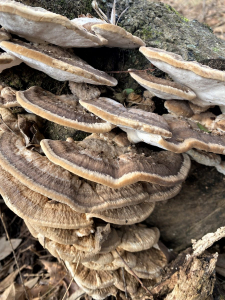
The mushrooms felt fresh and rubbery, with distinct pores on the underside (right image).
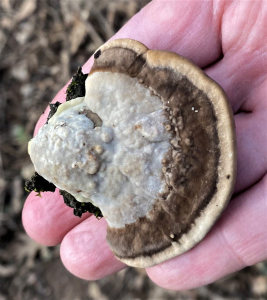
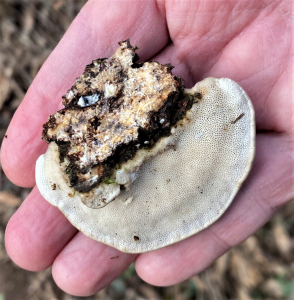
A dead sugarberry snag is frequented by pileated woodpeckers, as evidenced by the pile of punky chips at its base and the large rectangular trunkside excavations.
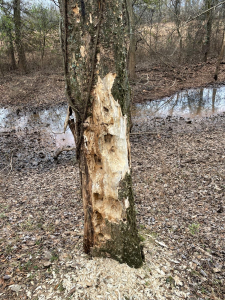
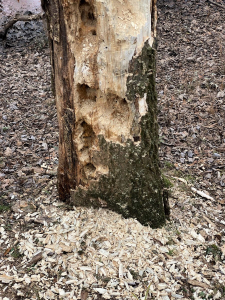
Another nearby sugarberry snag likewise carried pileated woodpecker cavities.
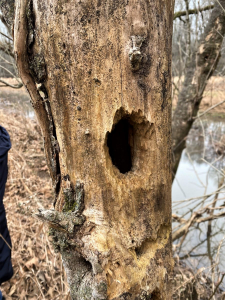
The dead sugarberry below still hoists its crown, albeit much diminished subsequent to death and decomposition, into the main canopy. Within three years I believe the trunk will yield to decay and gravity, falling to the ground to decay in-place or head downstream with the next flooding.
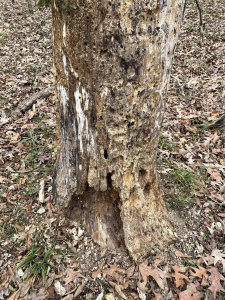
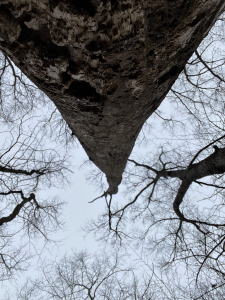
Two streambank sweetgum trees appear to be holding on to each other, resisting the undercutting flood waters that are eroding the bank and shifting the channel. These Flint River active riparian zones are constantly reshaped with each flood, some areas aggrading while others erode. The landscape is in dynamic flux. The sweetgums germinated and grew on a natural streamside levee; a migrating channel has now discovered the levee, cutting into and through it. The two trees will ultimately pay the price, no longer able to find adequate purchase to keep them erect.
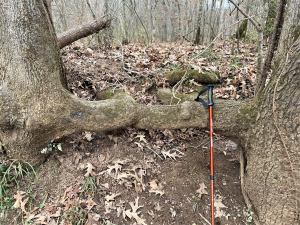
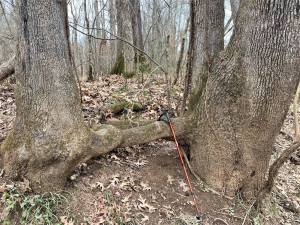
The Sanctuary is a dynamic, varied ecosystem, blessed with shifting ecotones and rich life.
Thoughts and Reflections
I offer these observations:
- Every element of Nature has a story to tell, and every story has lessons for life and living.
- I shall never lose my imagination…my curiosity about Nature.
- Albert Einstein: Imagination is more important than knowledge. Knowledge is limited. Imagination encircles the world.
Inhale and absorb Nature’s elixir. May Nature Inspire, Inform, and Reward you!
Note: All blog post images created & photographed by Stephen B. Jones unless otherwise noted. Please circulate images with photo credit: “©2022 Steve Jones, Great Blue Heron LLC. All Rights Reserved.”
Another Note: If you came to this post via a Facebook posting or by an another route, please sign up now (no cost… no obligation) to receive my Blog Post email alerts: http://eepurl.com/cKLJdL
And a Third: I am available for Nature-Inspired Speaking, Writing, and Consulting — contact me at steve.jones.0524@gmail.com
Reminder of my Personal and Professional Purpose, Passion, and Cause
If only more of us viewed our precious environment through the filters I employ. If only my mission and vision could be multiplied untold orders of magnitude:
Mission: Employ writing and speaking to educate, inspire, and enable readers and listeners to understand, appreciate, and enjoy Nature… and accept and practice Earth Stewardship.
Vision:
- People of all ages will pay greater attention to and engage more regularly with Nature… and will accept and practice informed and responsible Earth Stewardship.
- They will see their relationship to our natural world with new eyes… and will understand more clearly their Earth home.
Tagline/Motto: Steve (Great Blue Heron) encourages and seeks a better tomorrow through Nature-Inspired Living!
Steve’s Three Books
I wrote my books Nature Based Leadership (2016), Nature-Inspired Learning and Leading (2017), and Weaned Seals and Snowy Summits: Stories of Passion for Place and Everyday Nature (2019; co-authored with Dr. Jennifer Wilhoit) to encourage all citizens to recognize and appreciate that every lesson for living, learning, serving, and leading is either written indelibly in or is powerfully inspired by Nature.
I began writing books and Posts for several reasons:
- I love hiking and exploring in Nature
- I see images I want to (and do) capture with my trusty iPhone camera
- I enjoy explaining those images — an educator at heart
- I don’t play golf!
- I actually do love writing — it’s the hobby I never needed when my career consumed me
- Judy suggested my writing is in large measure my legacy to our two kids, our five grand kids, and all the unborn generations beyond
- And finally, perhaps my books and Blogs could reach beyond family and touch a few other lives… sow some seeds for the future


All three of my books (Nature Based Leadership; Nature-Inspired Learning and Leading; Weaned Seals and Snowy Summits) present compilations of personal experiences expressing my (and co-author Dr. Wilhoit for Weaned Seals and Snowy Summits) deep passion for Nature. All three books offer observations and reflections on my relationship to the natural world… and the broader implications for society. Order any and all from your local indie bookstore, or find them on IndieBound or other online sources such as Amazon and LifeRich.

